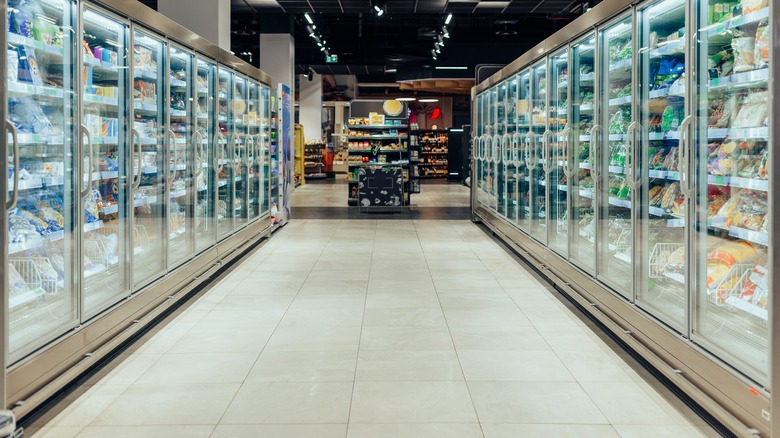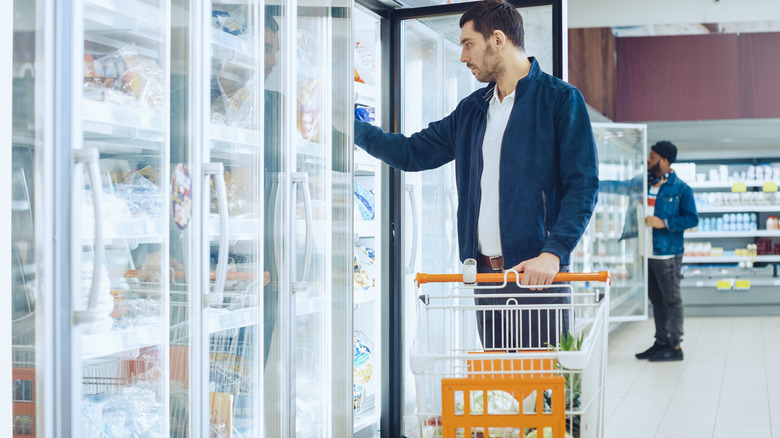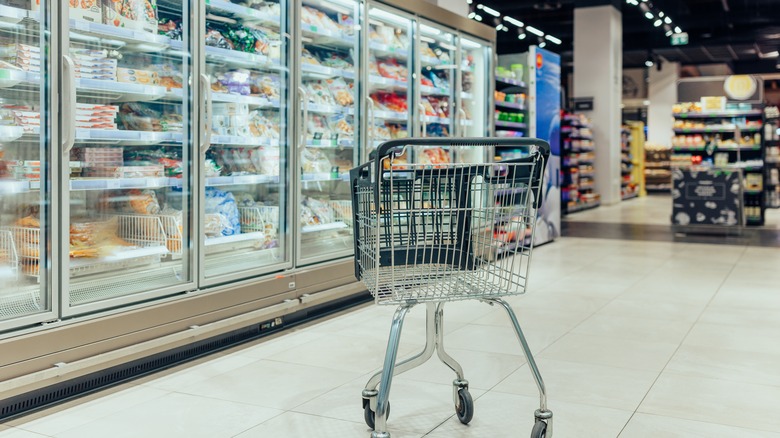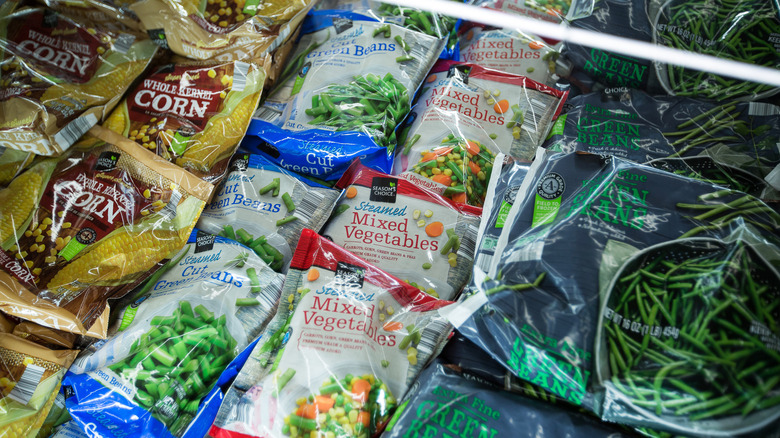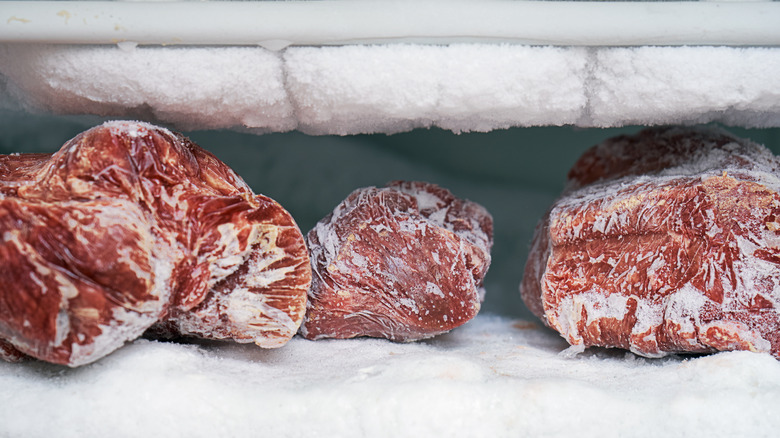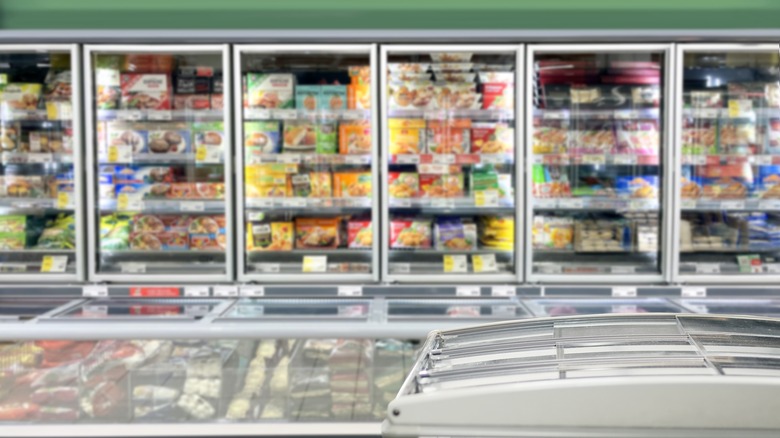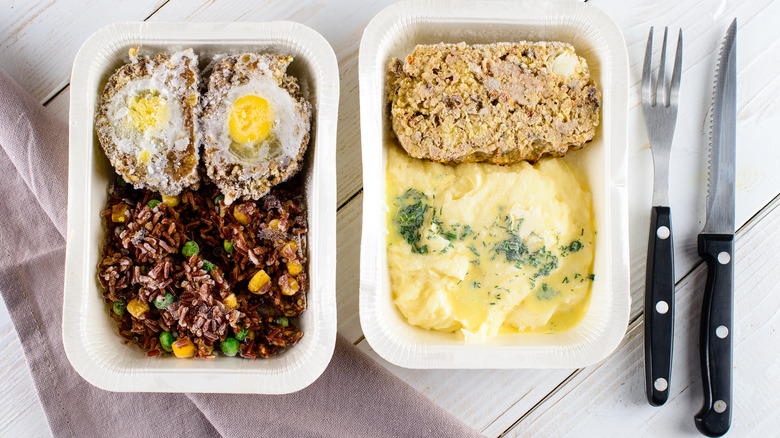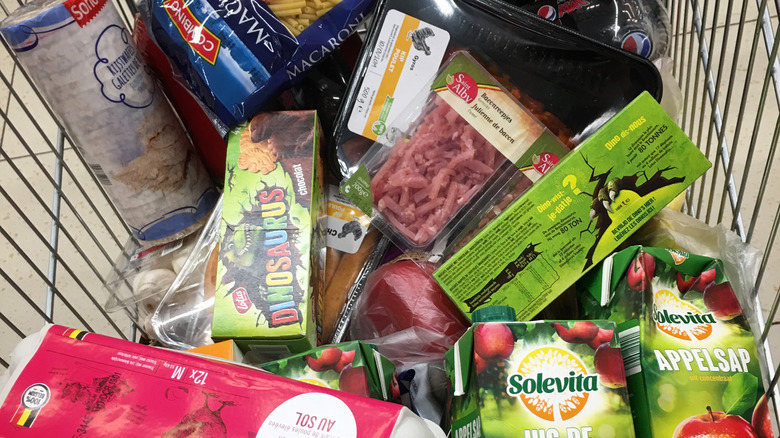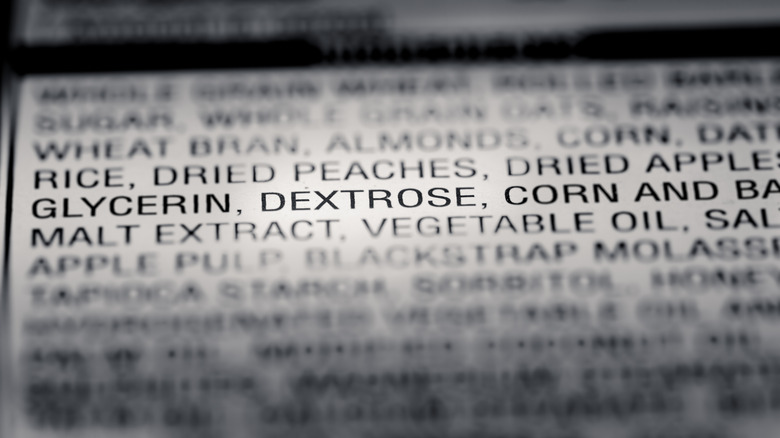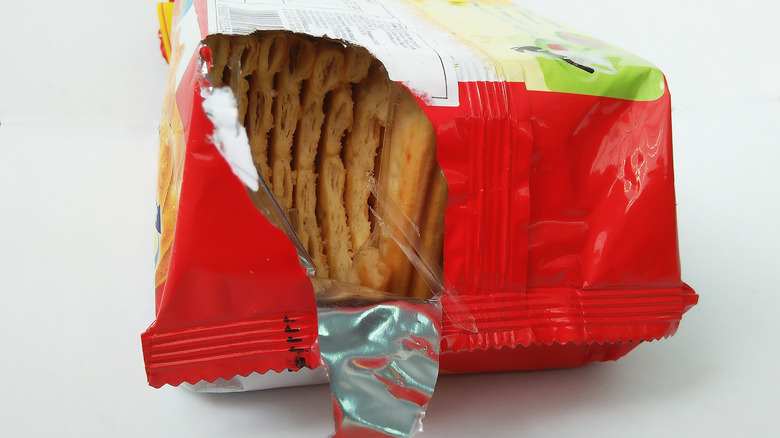Freezer Aisle Mistakes You Need To Stop Making
Whether you're on a budget, trying to reduce food waste, or aiming to minimize your carbon footprint, the freezer aisle at the supermarket should be one of your best friends. Frozen foods provide longevity and affordability that fresh foods often can't match, and, according to FoodSafety.gov, they're a terrific starting point for anyone learning to cook, because their preparation is often very simple. Yet, not everyone takes advantage of what these grocery store aisles have to offer, or if they do, they make some substantial mistakes that put the food and their health at risk.
From single- or double-serving frozen entrees to produce, family-size boxes of chicken to rice and beans, the freezer aisle is full of products that can help you change your daily diet for the better. If you haven't been giving the frozen food section a lot of thought lately, it's time to re-evaluate what you buy there. Consider whether you've been making some of these mistakes that could keep you from getting the full benefit that shopping in the freezer aisle can bestow.
Stop holding the door open
We hate to sound like your parents, but close the darn door if you're not taking something out of the freezer. You might not be responsible for the store's utility bills, but you're still wasting power by making the freezer's motor run more to accommodate the sudden influx of warm air (via Good Housekeeping). You're also creating additional thaw-freeze cycles for the food right at the front of the shelves.
You might not think this is such a big deal in stores, given that the ambient temperature can already feel kind of chilly, and because so many stores have refrigerated sections that are not enclosed. But, an open refrigeration case is not the same as a freezer case with an open door. Doorless vertical storage cases utilize air curtains, which are blasts of cold air that form a barrier between the cooled items and warmer store air (via University of Washington), and they're usually used in refrigerated units, not freezers. Cases with doors don't have that same barrier that stops warm air intrusion when the door is open; the door is the barrier. If you keep it open, you waste energy and risk thawing the food.
Stop shopping there first
If you head to the freezer section first, and then do the remainder of your grocery shopping, the time between you taking the food out of the freezer aisle and putting it into your freezer at home could be long enough to make the food unsafe to consume. The risk increases if you decide to stop somewhere else between the grocery store and home. Even quick stops, like getting gas, mean that the frozen food is going to thaw even more — and this is a big frozen food mistake. Instead, have the grocery store be your last stop for your errands, and make the freezer and refrigerator sections the last aisles you visit during your shopping trip, says North Dakota State University. If you know you're not going to bring frozen food home within 30 minutes, the Academy of Nutrition and Dietetics recommends keeping a cooler with ice or ice packs in your trunk.
But, you may say, total defrosting isn't immediate. Wouldn't food still be safe for a longer time because so much of it remains frozen? Well, not according to the USDA. Frozen food is still subject to the two-hour safety window (one hour when the outside temperature is above 90 degrees Fahrenheit). Think of it this way: When you take frozen food out of the freezer, it begins to defrost immediately. While some parts may remain frozen for a longer time, other parts have already thawed. Plus, your car's internal temperature may be a lot warmer than you think.
Stop ignoring the frozen vegetables and fruits
If you're going to buy anything from the freezer aisle, buy frozen fruits and vegetables. Stop passing these bags of goodness and pick up a few instead. This way, you'll always have some broccoli or corn on hand, along with mixes that will save you precious time when you want stir fry, but don't want to clean and chop up four different vegetables. The convenience and affordability of frozen produce can't be understated, and there are a few key reasons why.
Frozen produce is often more nutritious than fresh produce. Healthline says produce meant for the freezer is cleaned, cut, and frozen usually within a few hours of being picked, whereas fresh produce can sit in storage or on the shelf for days before you buy it — let alone eat it. That fast preparation and freezing preserves the nutrients in the frozen produce, while the fresh produce has no such safeguard against nutrient loss. Consumer Reports found that, after testing 369 samples of frozen fruits and vegetables, none of them contained dangerous bacteria. That's not to say that frozen produce can't contain bacteria; in fact, there have been outbreaks of foodborne illness stemming from frozen produce. Consumer Reports says it did not test for viruses, but, their testing did find that frozen produce carries little risk of bacterial contamination.
Stop buying the wrong package sizes
If frozen food lasts a very long time, then buying frozen food in bulk would be a great way to save money and reduce how much you need to shop, right? Not always. This sounds like a logical strategy, and, according to Ecomerge, buying in bulk is an excellent way to reduce your carbon footprint. However, the reality doesn't always meet expectations on the food storage front. When you buy a bag of frozen food that is much larger than you need, a lot of that food can suffer from freezer burn, which Inverse says can take hold after only a few months. The food may still be safe to eat, but who wants to chip pieces off an icy block of wrinkled broccoli?
Freezer burn is the result of the drying process that happens to frozen food over time. The better you package your food, the longer it will be before you see spots of freezer burn. If there is a bulk deal that you simply can't pass up, re-package the food before tossing it in your freezer. For example, the Food Safety and Inspection Service at the USDA recommends overwrapping meat and poultry that you intend to freeze long-term; the packaging from the store is good for short-term storage, but is too permeable for long-term use. The USDA also says that removing as much air from the package as possible is key for good long-term storage.
Stop avoiding the aisle completely
Eating fresh, in-season foods is a nice goal, but doing so to the point where you never go into the freezer aisle at all is another mistake. Frozen meals used to have a terrible reputation as something eaten only by dieters or families who'd rather sit in front of the TV than talk to each other. This reputation is undeserved, especially now, when so many brands are providing everything from superfoods to frozen meals full of protein and vitamins — they've realized that giving consumers the ability to store and eat these foods at their convenience is a boost for business (via The State Journal-Register).
Combine that availability with other frozen goods, like fruits and vegetables, and you can have a recipe for a diverse diet that doesn't require much time spent cooking. All that being said, you do still have to keep an eye out for problematic frozen food. Frozen meals that are too high in sodium are still common, says Healthfully, and the New York Post warns about ultra-processed foods and those with excessive calorie counts.
Stop skipping over most of the aisle
You may want to set aside some time to browse the freezer aisles as you could be missing out on some awesome products that could make your life easier and your meals healthier. Skipping over most of the frozen food aisle is a huge mistake, as you'll see more than just pizza snacks and ice cream once you venture past the frozen vegetables. For one thing, you'll find frozen versions of foods that normally spoil very quickly when you buy them fresh, such as avocado, or that you might not use up all at once, such as gyoza wrappers.
You'll also find precooked versions of foods that would otherwise take a long time to cook when dried or fresh, such as grains or beans. Insider interviewed chefs about the foods they recommend getting from the frozen section, and while some are not a surprise, others are ones you might not have considered. One chef said frozen red beans and rice was a winner because the beans were cooked properly, and you wouldn't risk overcooking them to the point where they become pasty. Another recommended frozen grains to cut down on the cooking time, which can be less-than-fast for non-frozen grains such as brown rice. If you trust yourself to look through all the offerings without buying too much and breaking your shopping budget, go see what the frozen sections at your nearby markets have to offer.
Stop buying packages that have ice on the outside
When you grab a frozen product off a freezer shelf, you might find traces of ice on it. If you find a lot of ice on it, though, put it back. Those ice crystals are a sign the product partially defrosted and then re-froze, says Today, and there's no way to know for how long the product was sitting in warmer temperatures. If the product contains food that should be loose, like frozen vegetables, put back any where the food inside the packaging has become a solid block and you can't easily break the pieces apart.
Even if the food was not stored in warmer temperatures for very long, the slower re-freezing process in a store's freezers can degrade the quality of the food. Most frozen food is quickly frozen by manufacturers, and Penn State Extension says that this rapid freezing creates smaller ice crystals in the product that do less damage to the food. When the food defrosts and then re-freezes in a store freezer, which isn't meant for flash-freezing, the ice crystals that form can rip apart the food's cells. The University of Minnesota Extension says this can lead to softer food, such as tomatoes that become mushy when thawed. This can make food that you intended to eat raw unappetizing, but it shouldn't be a problem if you plan to cook the food anyway.
Start paying attention to whether the food is precooked or raw
The packaging on a frozen meal may indicate that you'll get an appetizing dinner in just a few minutes, but that's only if you follow the instructions on the package and ensure the food is fully cooked, rather than just warm. Not all frozen food is fully precooked. In many cases, the ingredients in frozen meals are only partially cooked (or even raw), and if you don't follow the instructions, you could end up with undercooked food along with food poisoning. The USDA warns that you should check packages of frozen food for labels such as "ready to cook" or "cook and serve," which are clear signs the food inside is not something you can simply heat up.
Complicating this is the fact that the instructions for microwave cooking, if that's what you'll be using, rely on you having access to a microwave that uses the same wattage as the manufacturer's test kitchen. If the manufacturer's instructions are for a higher-watt microwave, and yours is of a lower wattage, you'll need to cook the product for a longer time to ensure it's fully cooked (via Michigan State University Extension). NBC News says you need to watch out for the age of the microwave as well; older microwaves typically have lost some of their power.
Stop putting frozen food on random shelves if you've changed your mind about buying it
A huge mistake people make in the freezer aisle actually occurs outside of it: putting frozen items they don't want on random shelves. To the people who do this, we ask you, do you not know how freezing works? It's bad enough when the unwanted frozen items are placed in the wrong freezer compartment, but when you leave them outside the freezer, they melt and ruin nearby products, not to mention becoming ruined themselves. Check out this picture of a box of melted Bomb Pops from Reddit and ask yourself if you'd want to buy that package, or anything that was placed in the trail of dripping syrup that stained the display shelves.
Users on Quora point out that having to go through the store and return misplaced items means the store needs more employees, which in turn raises costs for consumers. But it's not just the cost of hiring more employees that you have to worry about; it's the cost of dealing with the food waste and potential disinfection protocols. One Redditor noted that sometimes people will leave raw chicken on non-freezer and non-refrigerator shelves, and cleaning that up would require ensuring the shelving and adjacent packages are clean enough to safely handle. If you decide you don't want a frozen item, head back to the freezer aisle to return it.
Stop assuming those bags of basic foods don't contain other ingredients
Buying frozen vegetables and other basic foods allows you to keep healthy items on hand for a longer time and reduces food waste. Whereas fresh spinach might wilt within a week, frozen spinach can last for months before developing freezer burn. However, never assume that a frozen food product contains only the ingredients listed on the front of the bag; always check the actual ingredient label.
Healthline warns that simple frozen vegetables can have added sugar or salt, and that vegetable-sauce mixtures may have more calories, sodium, or fat than you realize. Even if these ingredients and nutrient counts are acceptable to you, you'll want to know they're in these products. The risk of added sodium is even worse if the frozen vegetables are part of a larger frozen meal. You may think you're buying a basic-looking meal with plain vegetables as the side dish, but Houston Methodist Hospital points out that these frozen meals may use excessive sodium as a preservative.
Start inspecting the packaging before putting the frozen food in your cart
Now that you're heading to the freezer section last, you grab some frozen food and are off to the register to pay. That speed may sound appealing, but it leads to a final mistake: not inspecting the packaging for damage. Some frozen goods, like vegetables in bags meant for microwave steaming, have special vents cut into them (via Quora). However, holes, uneven or large cuts, missing seals, or loose lids are signs that something happened to the packaging. These can occur by accident or be done deliberately. Either way, the product could contain unwanted substances. For example, in this Reddit thread, a user points out that the Lysol the original poster used to clean a ripped package of chicken nuggets could have gotten inside the bag and onto the food. And don't forget the instances of in-store ice-cream licking that have occurred through the years, such as this case in 2020.
Those more extreme examples aside, the packaging could allow anything from dust and bugs to germs inside the bag or container, and you waste food when you have to throw away something that you didn't check before buying. The FDA says that deliberate tampering is rare, but that they have stepped up inspections to address the possibility in food production settings. No need for paranoia, but you should look over each bag or box and notify a store employee if you find something that looks like it's been opened.
